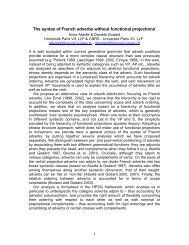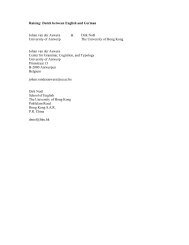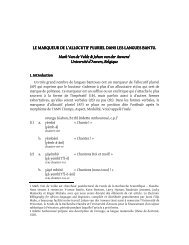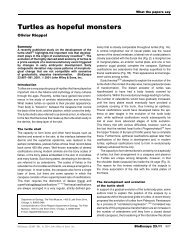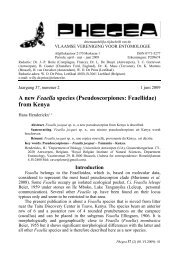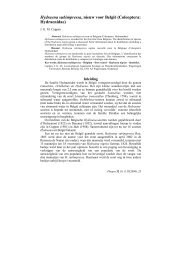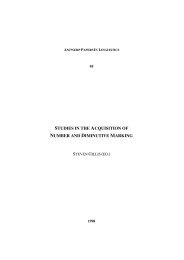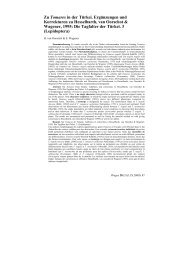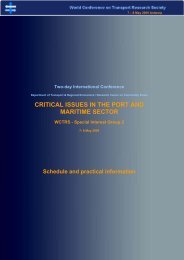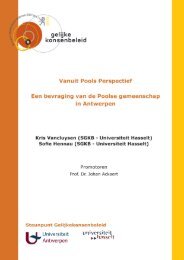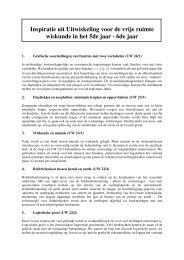Theodor2005.pdf
Theodor2005.pdf
Theodor2005.pdf
Create successful ePaper yourself
Turn your PDF publications into a flip-book with our unique Google optimized e-Paper software.
180 Theodor and Foss<br />
MacPhee, R. D. E. (1994). Morphology, adaptations, and relationships of Plesiorycteropus, and a diagnosis of a<br />
new order of eutherian mammals. Bull. Am. Mus. Nat. Hist. 220: 1–214.<br />
Milinkovitch, M. C., Bérubé, M., and Palsbøll, P. J. (1998). Cetaceans are highly derived artiodactyls. In: The<br />
Emergence of Whales: Evolutionary Patterns in the Origin of Cetacea, J. G. M. Thewissen, ed., pp. 113–132,<br />
Plenum, New York.<br />
Nikaido, M., Rooney, A. P., and Okada, N. (1999). Phylogenetic relationships among cetartiodactyls based on<br />
insertions of short and long interpersed elements: Hippopotamuses are the closest extant relatives of whales.<br />
Proc. Natl. Acad. Sci. U.S.A. 96: 10261–10266.<br />
Norris, C. A. (1999). The cranium of Bunomeryx (Artiodactyla: Homacodontidae) from the Upper Eocene<br />
Uinta deposits of Utah and its implications for tylopod systematics. J. Vertebr. Paleontol. 19: 742–<br />
754.<br />
Norris, C. A. (2000). The cranium of Leptotragulus, a hornless protoceratid (Artiodactyla: Protoceratidae) from<br />
the Middle Eocene of North America. J. Vertebr. Paleontol. 20: 341–348.<br />
Novacek, M. J. (1986). The skull of leptictid insectivorans and the higher-level classification of eutherian mammals.<br />
Bull. Am. Mus. Nat. Hist. 183: 1–112.<br />
O’Leary, M. (1998). Phylogenetic and morphometric reassessment of the dental evidence for a mesonychian and<br />
cetacean clade. In: The Emergence of Whales: Evolutionary Patterns in the Origin of Cetacea, J. G. M.<br />
Thewissen, ed., pp. 133–161, Plenum, New York.<br />
O’Leary, M. (1999). Parsimony analysis of total evidence from extinct and extant taxa and the cetacean–artiodactyl<br />
question (Mammalia, Ungulata). Cladistics 15: 315–330.<br />
O’Leary, M. A., and Geisler, J. H. (1999). The position of Cetacea within Mammalia: Phylogenetic analysis of<br />
morphological data from extinct and extant taxa. Syst. Biol. 48: 455–490.<br />
O’Leary, M. A., and Rose, K. D. (1995). Postcranial skeleton of the Early Eocene Mesonychid Pachyaena<br />
(Mammalia: Mesonychia). J. Vertebr. Paleontol. 15: 401–430.<br />
Pearson, H. S. (1927). On the skulls of early Tertiary Suidae, together with an account of the otic region in some<br />
other primitive Artiodactyla. Philos. Trans. R. Soc. Lond. B. Biol. Sci. 215: 389–460.<br />
Pickford, M. (1983). On the origins of Hippopotamidae together with descriptions of two new species, a new<br />
genus and a subfamily from the Miocene of Kenya. Geobios 16: 193–217.<br />
Prothero, D. R. (1993). Ungulate phylogeny: Molecular vs. morphological evidence. In: Mammal Phylogeny:<br />
Placentals, Vol. 2, F. S. Szalay, M. J. Novacek, and M. C. McKenna, eds., pp. 173–181, Springer-Verlag,<br />
New York.<br />
Rose, K. D., and O’Leary, M. A. (1995). The manus of Pachyaena gigantea (Mammalia: Mesonychia). J. Vertebr.<br />
Paleontol. 15: 855–859.<br />
Scott, K. M., and Janis, C. M. (1993). Relationships of the Ruminantia (Artiodactyla) and an analysis of the<br />
characters used in ruminant taxonomy. In: Mammal Phylogeny: Placentals, Vol. 2, F. S. Szalay, M. J.<br />
Novacek, and M. C. McKenna, eds., pp. 282–302, Springer-Verlag, New York.<br />
Shoshani, J. (1986). Mammalian phylogeny: Comparison of morphological and molecular results. Mol. Biol. Evol.<br />
3: 222–242.<br />
Sorenson, M. D. (1999). TreeRot, Ver. 2, Boston University, Boston, MA.<br />
Stucky, R. K. (1998). Eocene bunodont and bunoselenodont Artiodactyla (“dichobunids”). In: Evolution of<br />
Tertiary Mammals of North America, Vol. I: Terrestrial Carnivores, Ungulates, and Ungulatelike Mammals,<br />
C. M. Janis, K. M. Scott, and L. L. Jacobs, eds., pp. 358–374, Cambridge University Press, Cambridge, UK.<br />
Swofford, D. L. (2001). PAUP ∗ . Phylogenetic Analysis Using Parsimony ( ∗ and Other Methods). Version 4. Sinauer<br />
Associates, Sunderland, MA.<br />
Theodor, J. M. (1996). Phylogeny, Locomotor Evolution, and Diversity Patterns in Eocene Artiodactyla, PhD<br />
dissertation, University of California, Berkeley.<br />
Thewissen, J. G. M., and Domning, D. P. (1992). The role of phenacodontids in the origin of the modern orders<br />
of ungulate mammals. J. Vertebr. Paleontol. 12: 494–504.<br />
Thewissen, J. G. M., and Hussain, S. T. (1998). Systematic review of the Pakicetidae, early and middle Eocene<br />
Cetacea (Mammalia) from Pakistan and India. [In: Dawn of the Age of Mammals in Asia, M. R. Dawson,<br />
ed.]. Bull. Carn. Mus. Nat. Hist. 34: 220–238.<br />
Thewissen, J. G. M., Hussain, S. T., and Arif, M. (1994). Fossil evidence for the origin of aquatic locomotion in<br />
archaeocete whales. Science 263: 210–212.<br />
Thewissen, J. G. M., and Madar, S. I. (1999). Ankle morphology of the earliest cetaceans and its implications for<br />
the phylogenetic relations among ungulates. Syst. Biol. 48: 21–30.<br />
Thewissen, J. G. M., and Williams, E. M. (2002). The early radiations of Cetacea (Mammalia): Evolutionary<br />
pattern and developmental correlations. Annu. Rev. Ecol. Syst. 33: 73–90.<br />
Thewissen, J. G. M., Williams, E. M., Roe, L. J., and Hussain, S. T. (2001). Skeletons of terrestrial cetaceans and<br />
the relationship of whales to artiodactyls. Nature 413: 277–281.<br />
Uhen, M. D. (2000). Replacement of deciduous first premolars and dental eruption in archaeocete whales.<br />
J. Mamm. 81: 123–133.



